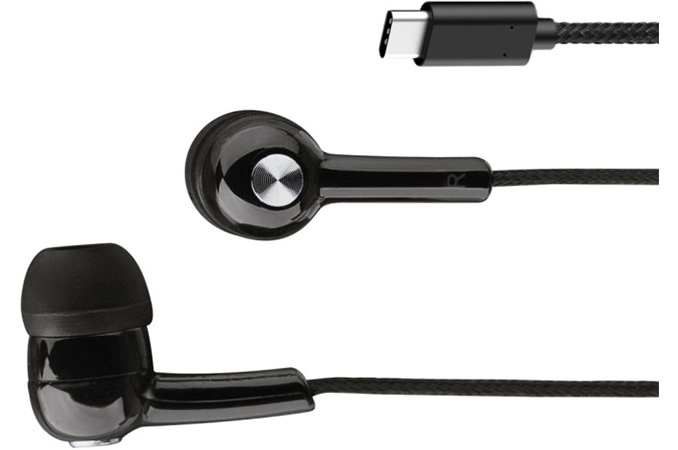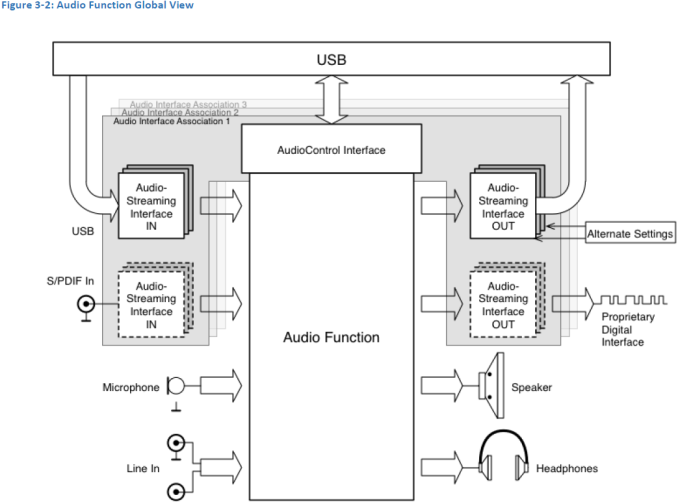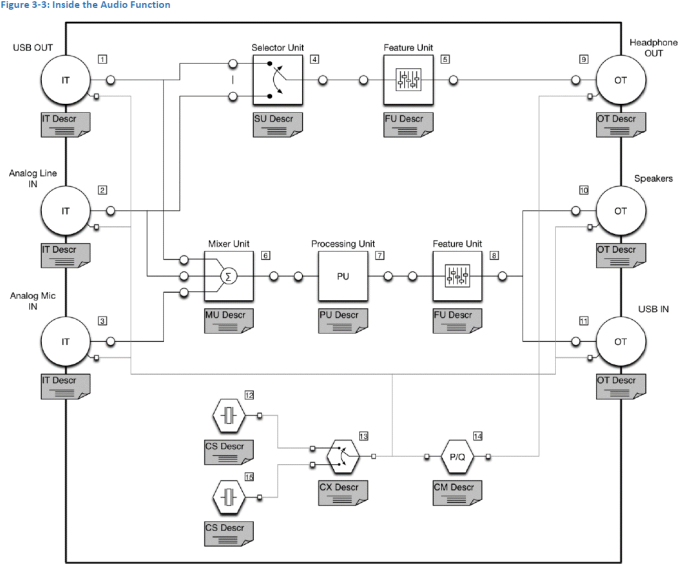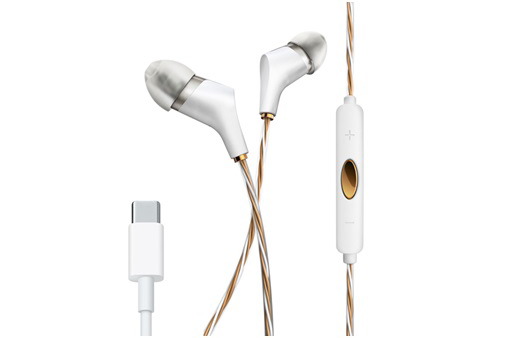USB-IF Publishes Audio over USB Type-C Specifications
by Anton Shilov on September 30, 2016 12:00 PM EST- Posted in
- Mobile
- USB-C
- USB-C Digital Audio

The USB Implementers Forum this week published the USB Audio Device Class 3.0 specification, which standardizes audio over USB Type-C interface. The new spec enables hardware makers to eliminate traditional 3.5mm mini-jacks from their devices and use USB-C ports to connect headsets and other audio equipment. Makers of peripherals can also build their audio solutions, which use USB-C instead of traditional analog connectors. Developers of the standard hope that elimination of mini-jacks will help to make devices slimmer, smarter and less power hungry.
The industry, led by Intel and some other companies, has been mulling about replacing the traditional 3.5mm mini-jack connector for some time now. The main motives for replacement were necessity to simplify internal architecture of devices by removing analog and some audio processing components from the inside (which leads to further miniaturization), minimize the number of external connectors, improve power management as well as to add smart features to headsets and other audio equipment. We discussed USB Type-C Audio Technology briefly earlier this year and mentioned that this is not the first time that the industry has tried to use USB instead of the good-old mini-jack. The important difference between contemporary initiative and attempts in the past is the fact that today the primary goal is to replace the 3.5mm jack in portable devices.
As reported, the USB Audio Device Class 3.0 specification supports both analog and digital audio. Analog audio is easy to implement and it does not impact data transfers and other functionality of USB-C cables since it uses the two secondary bus (SBU) pins. Some device makers may find the analog audio feature of the standard to be a relatively simple way to add certain smart capabilities to their headsets without major redesign of hosts. While analog USB-C audio will not help to shrink dimensions of portables, it could be particularly useful for non-mobile devices, where miniaturization is not crucial, but where port space is at a premium or where additional features either make sense (infotainment, sport equipment, etc.) or are fundamental (VR HMDs).
The USB ADC 3.0 defines minimum interoperability across analog and digital devices in order to avoid confusion of end-users because of incompatibility. In fact, all ADC 3.0-compliant hosts should support the so-called headset adapter devices, which allow to connect analog headsets to USB-C. However, digital audio is one of the primary reasons why companies like Intel wanted to develop the USB-C audio tech in the first place, hence, expect them to promote it.
According to the USB ADC 3.0 standard, digital USB-C headphones will feature special multi-function processing units (MPUs), which will, to a large degree, define the feature set and quality of headsets. The MPUs will handle host and sink synchronization (this is a key challenge for digital USB audio), digital-to-analog conversion, low-latency active noise cancellation, acoustic echo canceling, equalization, microphone automatic gain control, volume control and others. Such chips will also contain programmable amplifiers and pre-amplifiers, which are currently located inside devices. Besides, USB ADC 3.0-compatible MPUs will also support USB Audio Type-III and Type-IV formats (the latest compressed formats), but will retain compatibility with formats supported by ADC 1.0 and 2.0. Finally, among the mandated things set to be supported by USB-C Audio devices are new Power Domains (allows devices to put certain domains in sleep mode when not in use) as well as BADD (basic audio device definition) 3.0 features for saving power and simplified discovery and management of various audio equipment (each type of devices has its own BADD profile).
Over the past few months, Conexant has introduced three USB-C Audio MPUs (1, 2) for headsets, docking stations and other equipment. Assuming that these chips are compliant with the USB ADC 3.0 specs from a hardware standpoint, and the software is ready, actual devices featuring USB-C Audio could arrive in the coming months. Pricing of the first USB ADC 3.0-compliant MPUs is unknown, but in general MPU ICs do not cost too much. Moreover, as developers adopt smaller process technologies and a larger number of such chips hit the market, their prices are going to decline. In the end, it will be interesting to see where digital headphone prices end up. The MPUs will definitely add to the total bill of materials for a set of headphones, but at the same time they add new functionality as well, so the big question is how manufacturers then factor all of that into device pricing.
A number of companies, including Apple and LeEco, have already introduced smartphones that do not use traditional mini-jacks, and Google added support for USB DAC devices to Android over a year ago. The finalization of the USB ADC 3.0 spec, introduction of USB-C audio ICs, as well as design decisions of smartphone makers demonstrate that the industry is trying to eliminate 3.5mm jacks from mobile devices. The big question is whether the rest of the industry plans to do the same. It is true that portables are primary devices for music listening for many people. However, there are tens of applications which still rely on analog connectors, and hundreds of millions of people who use them either to consume or create content. To eradicate 3.5mm jacks completely, USB-C Audio promoters will have to work with thousands of vendors and this takes time. Consequently, it is too early to say that this is the end for the good-old mini-jack.
Images by Conexant, USB IF.
Source: USB IF













93 Comments
View All Comments
melgross - Saturday, October 1, 2016 - link
Jeeze. Your post is an example of what I'm saying. Analog audio from the 3.5mm jack is using a DAC. You do realize that? A DAC isn't needed in the audio chain in the phone, or other equipment, because that a digital stream. So the DAC and amp is in the headphones. There's a better chance of having a better DAC and amp in the headphone because of room, and the fact that it's on its own battery, if the manufacturer decides to to that for audio quality. This isn't really possible to do correctly otherwise.Impulses - Saturday, October 1, 2016 - link
Actually, there isn't, it's already astonishingly hard to make decent sounding headphones (even full sized ones, compared to speakers); and cramming a DAC and batteries in there doesn't help SQ at all... External DAC/amp solutions for audioohiles can and have netted an improvement, but the mass market isn't gonna carry an extra device for audio (just like they stopped caring about iPods). This is a side grade, at best. You're sorely misinformed about the technical aspects and what's currently possible.mr_tawan - Monday, October 3, 2016 - link
I think, making use of superior DAC in phone is kinda waste. Phones always suffer from all kind of surrounding noise. Portable players are way to go for those audiophiles.Impulses - Monday, October 3, 2016 - link
The point is this isn't being done in the name of sound quality, having a DAC crammed in a headphone cup along with moving parts, coils, magnets, batteries, and/or wires going to batteries in another cup is just as hostile and cramped an environment as the insides of a phone.melgross - Saturday, October 1, 2016 - link
As someone with an $80 thousand plus A/V system, I can tell you that the Hi-Fi forums are full of it. Most of the people there don't even know what this issue is all about (like some here, apparently).There are a lot of "high end" audio people who shun anything digital. Don't rely on what they say.
Impulses - Saturday, October 1, 2016 - link
And there are lots of high end audio people who are totally on top of the subject and while they do see the potential of this they also don't see the point of killing 3.5mm just yet. One of the most reputable headphone review sites out there (Inner Fidelity) has long held one of the most balanced stances on things like objectivism vs subjectivism and whatnot, and Tyll's reviews and headphone tear downs (which accompany almost every review) have long made it clear how hard it is to design an effective headphone cavity and resonance... So if you've never read any of that, as evidenced by your previous post, you're sorely ill informed on the subject despite the $80 grand epeen you're touting. Try again...Cinnabuns - Friday, September 30, 2016 - link
So...will existing USB-C devices be compatible these new USB-C headphones?BrokenCrayons - Friday, September 30, 2016 - link
"Developers of the standard hope that elimination of mini-jacks will help to make devices slimmer, smarter and less power hungry."I don't understand how a change in the audio connector will made a device smarter.
Impulses - Saturday, October 1, 2016 - link
That's the only nugget of this whole move that does have some truth behind it... A digital interface means they can put things like motion sensors on headphones and better communicate with them... 'Course that's all being done over Bluetooth with most wearables anyway, so even the biggest selling point rings kinda hollow.Communism - Friday, September 30, 2016 - link
It's going to be hilarious when you have to pay a monthly fee for the license to "lease" access to your USB-C headphone jack.And the license to verify that your USB-C headphone is "Certified."
And you better be sure your USB-C headphone is end to end "HDCP [insert arbitrary version number here]" compliant, or you won't be able to play that song you just purchased from [walled garden].